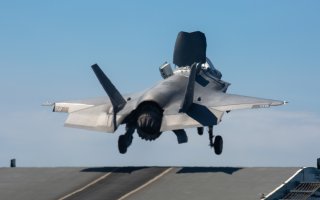Why the U.S. Marine Corps Ditched Their Important Radar Drone
The service is reconsidering its long-term plans for at-sea aviation.
Here's What You Need to Know: The move comes with its own costs.
The U.S. Marine Corps chose not to develop a ship-launched drone for the airborne early-warning role.
The decision weighs on the U.S. Navy’s plan to deploy some of its amphibious assault ships as “Lightning carriers” embarking as many as 20 F-35B stealth fighters.
The Marines had been counting on a variant of their in-development Marine Air Ground Task Force Unmanned Expeditionary Capabilities drone, or MUX, to carry a powerful radar in order to help manage air battles around amphibious groups.
But a big radar proved to be too heavy for the drone, Deputy Commandant of the Marine Corps for Aviation Lt. Gen. Steven Rudder told USNI News. The weight of the radar limited the vehicle’s endurance.
So instead of equipping the ship-launched drone with the radar, the Corps plans to add the sensor to a land-based vehicle.
“I think what we discovered with the MUX program is that it’s going to require a family of systems,” Rudder said. “Power output and weight capacity, obviously you get more weight and power output with a ground-based system with a longer runway, expeditionary runway, than you can coming vertically off the back of a ship. Shipboard compatibility continues to be a challenge for all our air vehicles.”
The shift to a land-based AEW drone could deprive Lightning carriers of an important capability. Radar planes such as the Navy’s E-2 help to spot targets and coordinate allied forces.
But AEW planes tend to be large. So large that only big carriers with catapults and arrestor wires, such as the U.S. Navy’s Nimitz- and Ford-class vessels and the French navy’s Charles de Gaulle, can launch and land them.
The Lightning carriers lack catapults and wires and can support only short-takeoff and vertically-landing aircraft. The British and Russian navies use radar-equipped helicopters for at-sea early-warning. The U.S. military doesn’t possess an AEW helicopter.
The Marines aimed to solve that problem by packing early-warning capability into a vertically-launching unmanned vehicle. Unfortunately for the service, that proved impossible.
The lack of organic AEW capability could become painful for the Navy and Marines as they look to expand on the Lightning-carrier concept. At present, only the fleet’s two America-class assault ships possess the facilities to support 20 vertical-landing F-35Bs.
But the Navy is reconsidering its long-term plans for at-sea aviation. The sailing branch in early 2020 launched a formal study of aviation-ship requirements after the current order for four Ford-class supercarriers.
The Navy’s new “Future Carrier 2030 Task Force” review dovetails with a second carrier study that’s underway inside the Office of the Secretary of Defense. The OSD study is due in the summer of 2020. It’s unclear when the Navy might release its own review.
Both studies could inform the Navy’s long-range shipbuilding plans and Congress’s own appropriations, which increasingly are shaping military force structure in the absence of feasible military planning.
One possible outcome is a greater emphasis on Lightning carriers. The U.S. fleet could opt to acquire more ships like America in addition to, or in place of, traditional supercarriers with their 60- or 70-plane air wings.
A 40,000-ton-displacement America-class vessel costs just $4 billion or so, compared to $14 billion for a supercarrier displacing 100,000 tons. In theory, the Navy could buy larger numbers of small carriers and distribute them more widely across the ocean, helping the fleet to avoid missile attacks.
But a possible move to smaller carriers comes with its own cost. Lighting carriers might be cheaper than supercarriers are, but they carry far fewer planes than the bigger vessels do and can sustain fewer sorties.
A Lightning carrier embarking 20 F-35s, compared to the roughly 40 strike fighters that a supercarrier normally carries, should be able to launch 40 sorties per day, the Marines estimated. A Ford-class supercarrier, by contrast, is supposed to be able to launch 160 sorties per day.
And with the Marines giving up on their radar-equipped drone, the small carriers likely will lack the wide sensor coverage that the bigger vessels can project.
David Axe served as Defense Editor of the National Interest. He is the author of the graphic novels War Fix, War Is Boring and Machete Squad.
This article first appeared in March 2020.
Image: U.S. Marine Corps photo by 1st Lt. Zachary Bodner

